The most
general notions reflecting the most general properties of phenomena
are called categories.
As for the
grammatical category itself, it presents a
unity of form
(that is material factor), and
meaning
(ideal factor). In other terms it presents a unity of content and
expression. The plane of content (ex. plurality) comprises the purely
semantic elements contained in the language while the plane of
expression (ex. boys) comprises the material (formal) units of the
language. The two planes are inseparably connected, so that no
meaning can be realized without some material means of expression.
The
ordered set of grammatical forms expressing a category is a
paradigm.
Paradigms
may be small and large, depending on the number of grammatical
categories they express; (ex: the paradigm of the word ‘man’
consists of 4 forms: a man – men (number), man’s – men’s
(case)).
Parts of
speech
represent larger paradigms possessing particular paradigms of case,
number (noun), degrees of comparison (adjective, adverb), tense,
voice, mood, person (verb), etc. Bigger paradigms after parts of
speech are morphology and syntax. The biggest paradigm of a language
is its grammatical structure.
The
paradigms in a category are arranged in the form of grammatical
oppositions.
The elements of the opposition have two
types of features:
common features and differential features.
In the opposition ‘boy-boys’ the common features is number, the
differential features are singularity (boy)/plurality (boys).
The
opposition along the line of one grammatical category is called an
opposeme,
ex. number opposeme: a table – tables.
The
oppositional theory was originally formulated as a
phonological theory.
The qualitative oppositions are privative
(b-d-g, p-t-k); gradual
(постепен)
— (i:-i-e-a) and equipollent
(равноцен)
– (m-b). By the number of members were divided into binary,
ternary (тройной),
quaternary
(четвертной),
etc. The most important type of opposition is the
binary privative opposition.
It is formed by a contrastive pair of members in which one member is
characterized by the presence of a certain differential feature while
the other member is characterized by the absence of this feature. The
member in which the feature is present is called the ‘marked’ or
‘strong’, or ‘positive’ member, and has the symbol ‘+’
(plus); the member in which the feature is absent — the ‘unmarked’
or ‘weak’, or ‘negative’ member, (minus).
The
gradual opposition
is formed by a contrastive group of members and shows the degree of
feature.
The
equipollent opposition
is formed by members which have different positive features.
The most
important type of opposition in morphology, the same as in phonology,
is the binary
privative opposition.
Ex. in the opposition ‘work-worked’ the marked member is ‘worked’
because it has the differential feature, the morpheme –ed, while
the unmarked member ‘work’ has no differential feature.
Equipollent
oppositions
in English morphology are rare (редкий).
Ex. the correlation of the person forms of the verb ‘be’ — am — is —
are. An example of the gradual
morphological opposition
can be seen in the category of comparison: strong — stronger – the
strongest. Both equipollent and gradual oppositions can be reduced to
privative oppositions.
In various
contextual
conditions,
one member of an opposition can be used in the position of the other,
counter-member. This phenomenon is called oppositional
reduction.
Ex. the opposition present – future: start – shall start, has
been reduced in the sentence (ex. Tonight we start for London) as the
weak member ‘start’ replacing the strong member ‘shall start’.
This
kind of oppositional reduction is called neutralization of
opposition. There is another kind of reduction, by which one of the
members of the opposition is placed in conditions uncommon for it.
This use is stylistically marked. (Ex. This man is constantly
complaining of something.) This contradiction intensifies the implied
disapproval of the man’s behavior.
Соседние файлы в папке Gosy
- #
- #
- #
- #
- #
- #
- #
Categorial Structure of the Word
1. Definition of the Word
There are many definitions of the term ‘word’ and none of them is generally accepted. But usually people experience no difficulty in separating one word from another in their native tongue. The analysis of numerous definitions of this term is the domain of lexicology. For the purposes of theoretical grammar we’ll accept the following one:
“A word is a free lingual unit (свободная языковая единица) that cannot be divided wholly into smaller free units that can be used to build a sentence.”
There are often restrictions on the phonetic make-up of the word, e.g. English words cannot begin with the sounds [ŋ] and [Ʒ]. The position of a stress is often fixed, that is, it is determined by the boundaries of words or their syllabic structure. Elements within words show greater cohesion ([ko’hi:Ʒn] – связь]) than within larger units. Thus, stems and affixes cannot be separated except by other affixes. Nor does the order of their elements tend to vary.
Distinctions are often drawn:
1. Between a phonological word or word as seen from the viewpoint of phonology, and a grammatical word, established by grammatical criteria only;
2. Between words distinguished in the lexicon (e.g. sing) and the individual word-forms that they can possess (e.g. sang, sung, singing).
2. The Hierarchy of Levels
(1) The lowest level of lingual segments is pho’nemic. It is formed by ‘phonemes. The phoneme has no meaning, its function is purely differential. It differentiates morphemes and words: pit – bit, bit – beat, etc.
(2) The next level is the mor’phemic one. The ‘morpheme is the elementary meaningful part of the word.
(3) The third level is the level of words, or le’xemic level. The word is different from the morpheme. The morphemes express abstract, ‘significative’ meanings which are used as constituents for the formation of more concrete, ‘nominative’ meanings of words. The word is a directly naming , nominative unit of language; it names things and their relations.
(4) The next higher level is the level of phrases (word-groups).
(5) Above the level of phrases lies the level of sentences.
(6) The 6th level comprises topical grouping which are defined as ‘dictemes, or elementary topical segmental units of the continual text. In the printed text, these grouping coincide with paragraphs.
3. The Lexeme. The ‘Grammeme
While a word may have only one phonological form (sheep, sg. – sheep, pl.), this is not always the case. Let’s, for example, take GO and WENT. Native speakers of English know that these are different forms of the same word. That’s why it is necessary to distinguish between the abstract vocabulary word GO and the phonological and orthographical forms it can take: goes, gone, went, going. We can think of these forms as the realizations (in sound and print) of the abstract vocabulary word. Linguists call such an abstract vocabulary word a lexeme. It means that a single lexeme can have a variety of word-form realizations. The number of these realizations in an English lexeme may vary from one (e.g. always, sheep) to several dozens.
Now let’s take the form ‘goes’. The suffix –(e)s has such meaning as 1) present tense, 2) 3rd person, 3) singular number, 4) active voice, 5) indicative mood.
This form is a grammeme. When we speak of a word as a grammeme we don’t think of its lexical meaning. We concentrate on the kind of grammatical information it carries. The lexical meaning is irrelevant for the detection of the type of grammeme. So, ‘goes’, ‘runs’, ‘stands’, ‘sits’, etc. is one grammeme.
For practical purposes of grammatical description the term ‘word-form’ is usually used.
A grammeme may be analytical by structure, which means that it may consist of more than one element: will go, have gone. An analytical grammeme is equivalent to one word-form.
Morphemes and grammemes are directly observable units by nature, lexemes are not.
4. The Categorial Grammatical Meaning. The Paradigm.
Notional words, first of all verbs and nouns, possess some morphemic features expressing grammatical (morphological) meanings. These features determine the grammatical form of the word, that is, the type of grammeme.
Grammatical meanings are very abstract, very general, therefore the grammatical form is not confined to an individual word, but unites a whole class of words: plural of nouns – boys, girls, dogs, buildings, trees, etc.; 3rd person, sg. of verbs – runs, takes, gives, etc.
The most general meanings rendered by language and expressed by systemic correlations of word-forms are called categorical grammatical meanings. Thus, the categorical grammatical meaning unites the individual meanings of the correlated word-forms and is exposed through them. The correlated word-forms carry specific grammatical information. They form a paradigm. A grammatical paradigm formed by the ordered set of grammatical word-forms expresses a categorical grammatical meaning.
For example, the verb forms ‘am speaking, is speaking, are speaking, was speaking, were speaking, etc.’ are units with a common meaning that brings them together into one paradigm. This common meaning is the grammatical meaning of duration or development.
Grammatical paradigms express various grammatical categories. The minimal paradigm consists of two word-forms. This kind of paradigm we see, for example, in the category of noun number: boy – boys.
A more complex paradigm can be divided into two, three and more subparadigms.
The Paradigm of Personal Pronouns
Singular
The nom. form The obj. form The poss. form The poss. form (absolute)
I me my mine
he him his his
she her her hers
it it its its
Plural
we us our ours
you you your yours
they them their theirs
5. The Grammatical Opposition
The paradigmatic correlations of grammatical forms in a category are exposed by the so-called grammatical oppositions. The opposition is a correlation of lingual forms by means of which a certain function is expressed.
The correlated members of the opposition possess two types of features: common features and differential ones. Common features serve as the basis of contrast, while differential ones express the function in question.
There are 3 main qualitative types of opposition: privative [‘prIvqtIv], gradual [‘grxdjVql], equipollent [IkwI’pOlqnt].
By the number of members, oppositions are divided into binary (two members) and more than binary – ternary [‘tWnqrI] (three members), quaternary [kwq’tWnqrI] (four members), etc.
The binary privative opposition is formed by a pair of members in which one member is characterized by the presence of a certain differential feature (“mark”), while the other member is characterized by the absence of this feature.
The member in which the feature is present is called the marked, or strong, or positive member; the member in which the feature is absent is called the unmarked, or weak, or negative member: boy – boys; strong – stronger; democratic – antidemocratic.
The gradual opposition is formed by a group of members which are distinguished not by the presence or absence of a feature, but by the degree of it: strong(ø) – stronger – strongest.
The equipollent opposition is formed by a pair or group in which the members are distinguished by different positive features: phenomenon – phenomena.
It is difficult to find the examples of this kind of opposition in English morphology (am – is – are), but in lexicology the best known examples are antonyms, that is, the pairs of antonyms having different roots: alive – dead, progressive – reactionary, etc.
The most important type of opposition is the binary privative opposition. The other types are reducible to it: strong – stronger – strongest > strong – stronger, strong – strongest; productive – wasteful > productive – unproductive.
6. Oppositional Substitution (Reduction)
In various contextual conditions, one member of an opposition can be used in the position of the other member. This is called ‘oppositional substitution’, or ‘oppositional reduction’, e.g.
The train leaves tomorrow.
The verb in this sentence has the form of the present indefinite while its meaning in the context is the future. So, the weak member (the present tense form) has replaced the strong member (the future tense form). The oppositional substitution shown in the above given sentence is stylistically indifferent. This kind of oppositional substitution is referred to as neutralization. The position of neutralization is filled in by the weak member of the opposition due to its more general semantics.
Alongside the neutralizing substitution (or reduction) there exists another kind of reduction when the use of the form is stylistically coloured. E.g. He is constantly grumbling.
The form of the present continuous here stands in sharp contradiction with its regular grammatical meaning “action in progress at the present moment”. The contradiction is purposeful: exaggeration.
This kind of oppositional substitution belongs to the domain of transposition. Transposition may be defined as a contrastive use of the counter-member of the opposition. As a rule, the strong member (or the counter-member) of the opposition is transpositionally employed. The stylistic colouring is explained by the comparatively limited regular functions of the strong member (limited semantics).
7. Synthetic(al) and Analytical Grammatical Forms
The grammatical forms fall under two main groups: synthetic and analytical.
Synthetic grammatical forms are realized by the inner morphemic composition of the word, while analytical grammatical forms are built up by a combination of at least two words: a grammatical auxiliary and a word of “substantial” meaning.
Synthetic grammatical forms are based on (1) inner inflexion, (2) outer inflexion and (3) suppletivity.
Inner inflexion, or phonemic vowel interchange, is not productive now: take – took, man – men, etc.
Suppletivity is not productive too. It is based on the correlation of different roots in one paradigm: go – went, good – better.
Outer inflexion is more productive. It is represented by grammatical suffixation: table – tables, take – takes, large – larger, etc. Grammatical prefixation can only be found in Old English.
The synthetic grammatical forms in English are used to build up (1) the number and case forms of the noun (boy – boys, boy – boy’s); (2) the person-number and tense of the verb (take – takes; work – worked), (3) participial and gerundial forms of the verb (take – taken, work – worked, take – taking), (4) the comparison forms of the adjective and adverb.
In the oppositional correlations of all these forms, the initial paradigmatic form of each opposition is distinguished by a zero suffix: boy + Ø – boy + s.
The forms consisting of two or more words are not always recognized as the analytical ones. Many linguists call them peri’phrastic constructions, or structures. The problems connected with the analytical form were investigated mostly by Russian grammarians. They have developed the criteria for the identification of analytical forms.
For example, the main features of a verbal analytical form are the following:
(1) It is a collocation of a constant element which is manifested by an auxiliary finite verb in one of the tense forms, and a variable element – notional verb. The notional verb stands in one of the non-finite forms – infinitive, participle I, participle II.
(2) This collocation is indivisible in grammatical sense, though its components are separate words.
(3) The auxiliaries are limited in number and fixed.
(4) The analytical form has an unlimited range of occurrence [q`kArqns] as a grammatical unit. It covers the whole of the verbal lexicon.
Grammatical categories
The grammatical categories are realized by the types of forms organized in paradigmatic oppositions, e.g. girl — girls (the category of number), large — larger (the category of comparison), etc. They can be divided into immanent categories, that is, categories innate for a given class of words, and reflective categories, that is, categories serving as a sign of correlation with some other class. Reflective categories are categories of a secondary, derivative semantic value.
For instance, the categories of number and person for nouns and pronouns are immanent, while the verbal person and the verbal number are reflective because the forms of these categories are based on grammatical agreement (The boy is smiling. The boys are smiling). For verbs the immanent categories are those of tense, aspect, voice and mood.
These is another important division of grammatical categories. The feature expressed by the category can be either constant (unchangeable) or variable (changeable).
Variable feature categories can be seen in the nominal number (singular — plural), the degrees of comparison (positive — comparative — superlative), the verbal tense, etc.
An example of a constant feature category can be seen in the category of gender.
Constant feature categories reflect the static classifications of phenomena, while variable feature categories expose various connections between phenomena.
Слайд 1
Categorization
Categorization in its most general sense can be
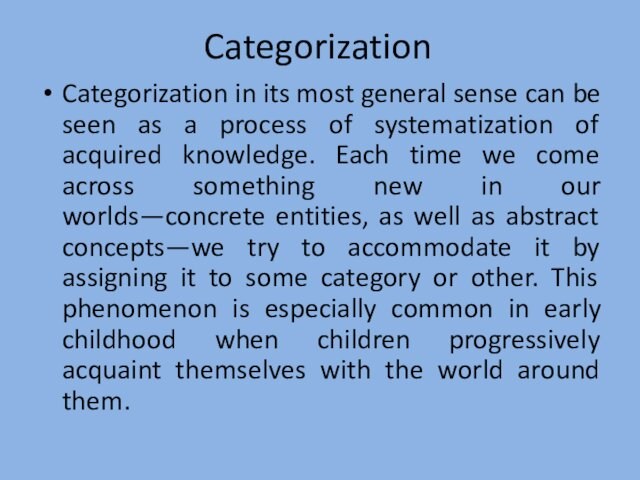
seen as a process of systematization of acquired knowledge.
Each time we come across something new in our worlds—concrete
entities, as well as abstract concepts—we try to accommodate it by assigning it to some category or other. This phenomenon is especially common in early childhood when children progressively acquaint themselves with the world around them.
Слайд 2
However, knowledge systematization in fact occurs throughout the
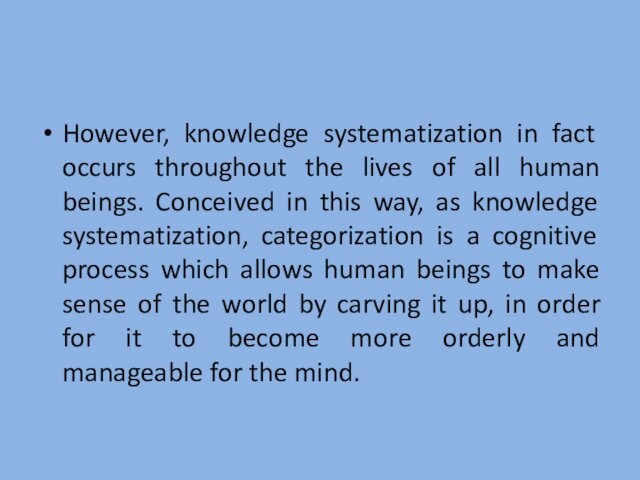
lives of all human beings. Conceived in this way,
as knowledge systematization, categorization is a cognitive process which allows
human beings to make sense of the world by carving it up, in order for it to become more orderly and manageable for the mind.
Слайд 3
category
A class or division of people or things
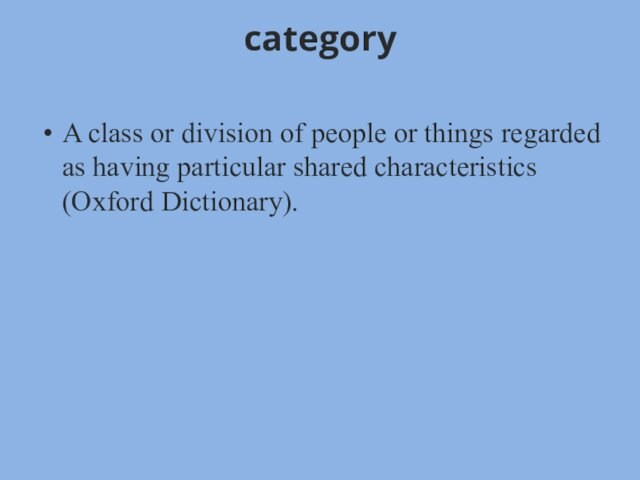
regarded as having particular shared characteristics (Oxford Dictionary).
Слайд 4
In linguistics categorization is of paramount importance. Language

in its spoken form is no more than a
stream of sounds, and traditionally linguistics has been concerned with
the mapping of these sounds on to meaning. This process is mediated by syntax which is concerned with the segmentation of linguistic matter into units, namely categories of various sorts, and groupings of one or more of these categories into constituents. In present-day linguistics, it is safe to say, no grammatical framework can do without categories, however conceived.
Слайд 5
Categorization is no trivial matter. There is very

little consistency or uniformity in the use of the
term “category” in modern treatments of grammatical theory: different linguists
have used wider or narrower definitions of what they regard as linguistic categories.
Слайд 6
Conceptions of categorization in the history of linguistics
Throughout
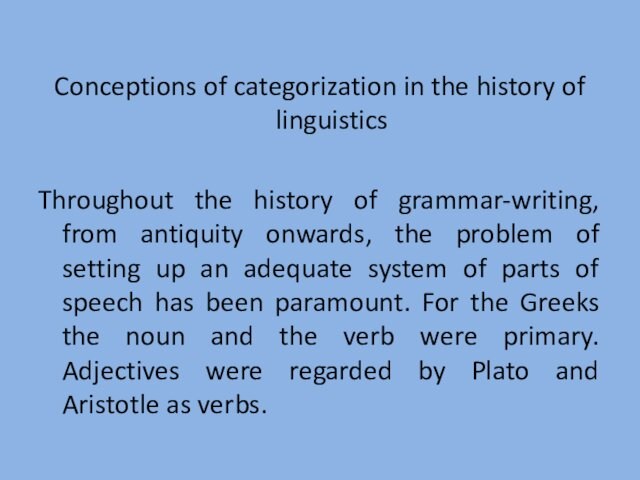
the history of grammar-writing, from antiquity onwards, the problem
of setting up an adequate system of parts of speech
has been paramount. For the Greeks the noun and the verb were primary. Adjectives were regarded by Plato and Aristotle as verbs.
Слайд 7
The word category (from Greek kate´goria) derives from
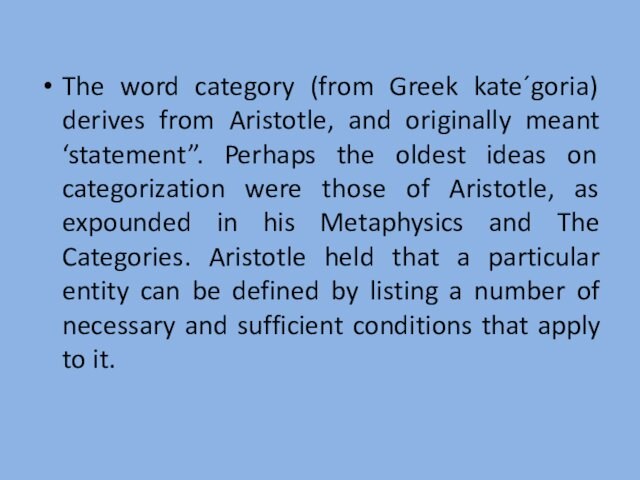
Aristotle, and originally meant ‘statement”. Perhaps the oldest ideas
on categorization were those of Aristotle, as expounded in his
Metaphysics and The Categories. Aristotle held that a particular entity can be defined by listing a number of necessary and sufficient conditions that apply to it.
Слайд 8
As an example, consider Aristotle’ s well-known definition
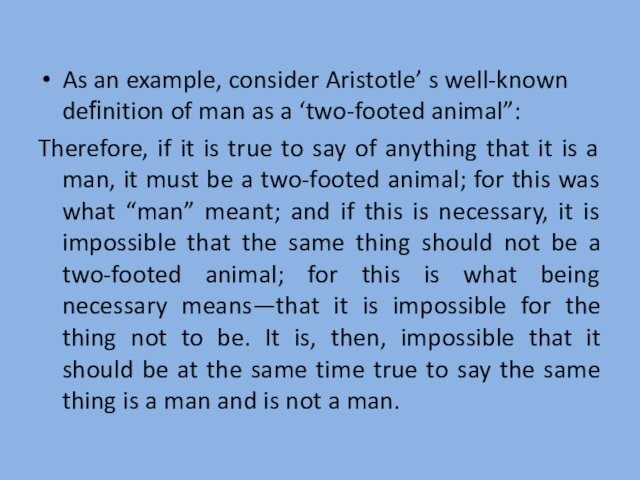
of man as a ‘two-footed animal”:
Therefore, if it is
true to say of anything that it is a man,
it must be a two-footed animal; for this was what “man” meant; and if this is necessary, it is impossible that the same thing should not be a two-footed animal; for this is what being necessary means—that it is impossible for the thing not to be. It is, then, impossible that it should be at the same time true to say the same thing is a man and is not a man.
Слайд 9
In other words, a particular entity cannot at
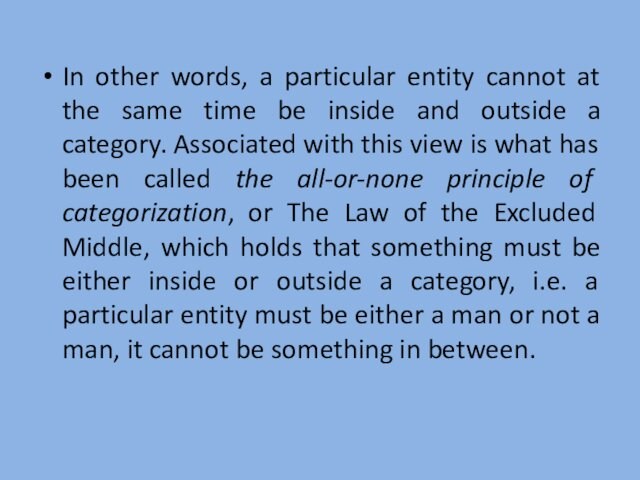
the same time be inside and outside a category.
Associated with this view is what has been called the
all-or-none principle of categorization, or The Law of the Excluded Middle, which holds that something must be either inside or outside a category, i.e. a particular entity must be either a man or not a man, it cannot be something in between.
Слайд 10
As has often been observed by many writers,
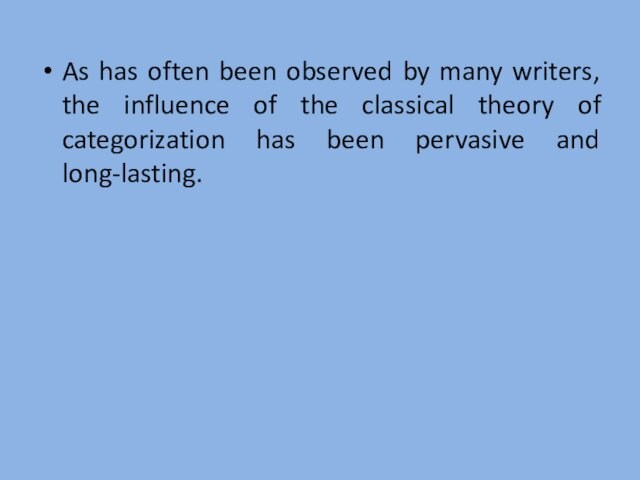
the influence of the classical theory of categorization has
been pervasive and long-lasting.
Слайд 11
The linguistic tradition
There has been a long tradition
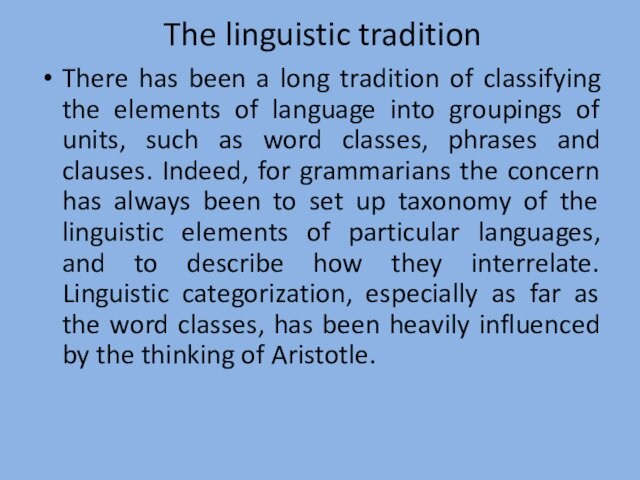
of classifying the elements of language into groupings of
units, such as word classes, phrases and clauses. Indeed, for
grammarians the concern has always been to set up taxonomy of the linguistic elements of particular languages, and to describe how they interrelate. Linguistic categorization, especially as far as the word classes, has been heavily influenced by the thinking of Aristotle.
Слайд 12
APPROACHES
H. Sweet is a prominent English grammarian. His
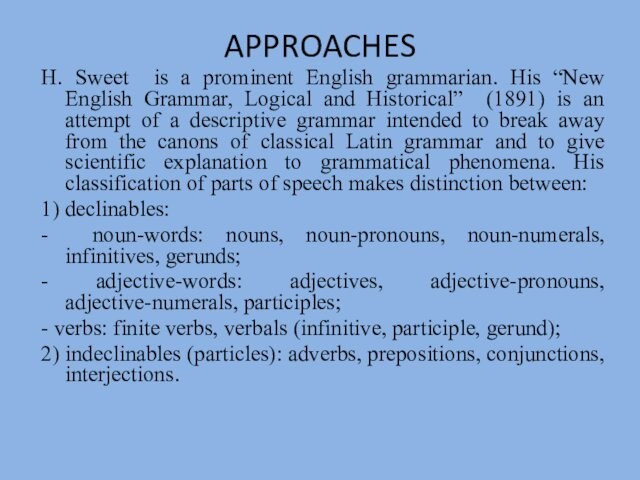
“New English Grammar, Logical and Historical” (1891) is an
attempt of a descriptive grammar intended to break away from
the canons of classical Latin grammar and to give scientific explanation to grammatical phenomena. His classification of parts of speech makes distinction between:
1) declinables:
— noun-words: nouns, noun-pronouns, noun-numerals, infinitives, gerunds;
— adjective-words: adjectives, adjective-pronouns, adjective-numerals, participles;
— verbs: finite verbs, verbals (infinitive, participle, gerund);
2) indeclinables (particles): adverbs, prepositions, conjunctions, interjections.
Слайд 13
Decline
with object (in the grammar of Latin, Greek, and
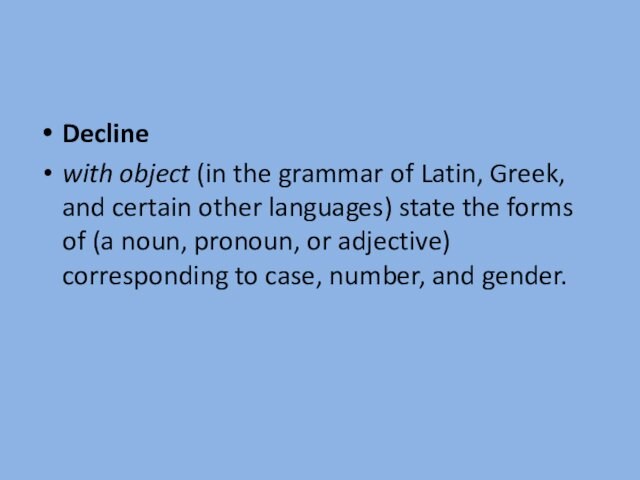
certain other languages) state the forms of (a noun,
pronoun, or adjective) corresponding to case, number, and gender.
Слайд 14
H. Sweet could not fully disentangle himself from
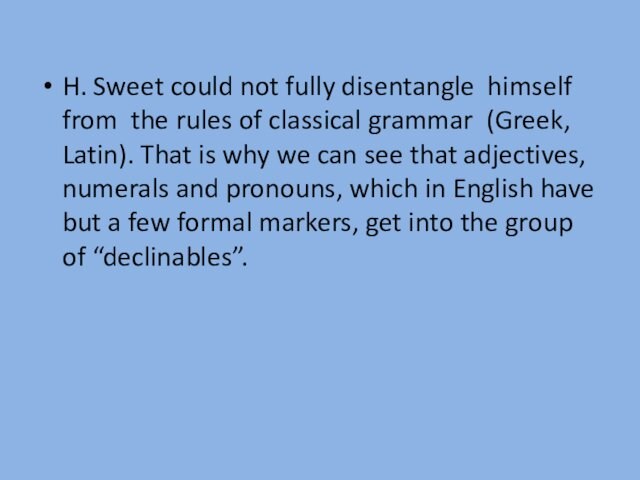
the rules of classical grammar (Greek, Latin). That is
why we can see that adjectives, numerals and pronouns, which
in English have but a few formal markers, get into the group of “declinables”.
Слайд 15
Ch. Fries’s book “The Structure of English” (1952).
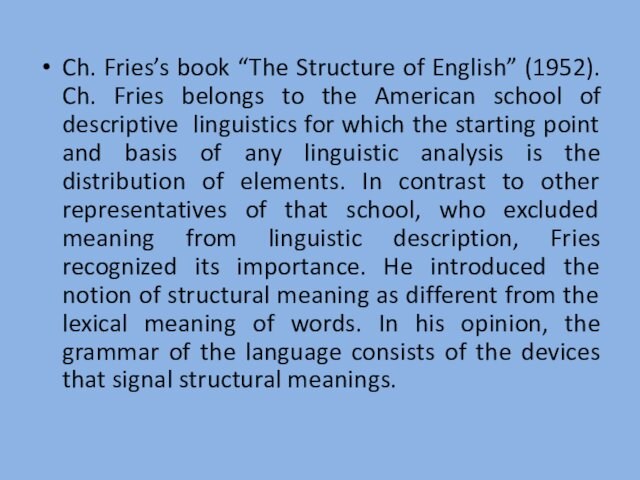
Ch. Fries belongs to the American school of descriptive
linguistics for which the starting point and basis of any
linguistic analysis is the distribution of elements. In contrast to other representatives of that school, who excluded meaning from linguistic description, Fries recognized its importance. He introduced the notion of structural meaning as different from the lexical meaning of words. In his opinion, the grammar of the language consists of the devices that signal structural meanings.
Слайд 16
This principle is illustrated by means of linearly
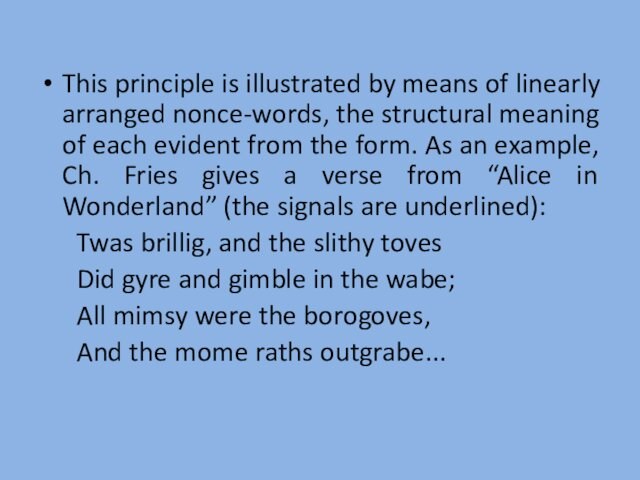
arranged nonce-words, the structural meaning of each evident from
the form. As an example, Ch. Fries gives a verse
from “Alice in Wonderland” (the signals are underlined):
Twas brillig, and the slithy toves
Did gyre and gimble in the wabe;
All mimsy were the borogoves,
And the mome raths outgrabe…
Слайд 17
Twas brillig, and the slithy toves
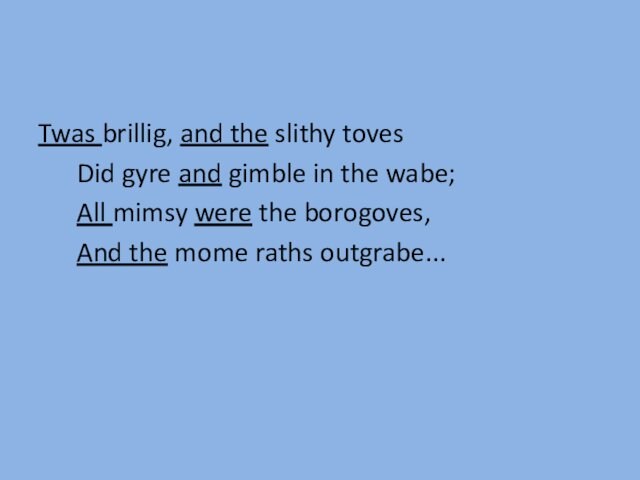
Did gyre and gimble in the wabe;
All mimsy were the borogoves,
And the mome raths outgrabe…
Слайд 18
Any speaker of English, says Fries, will recognize
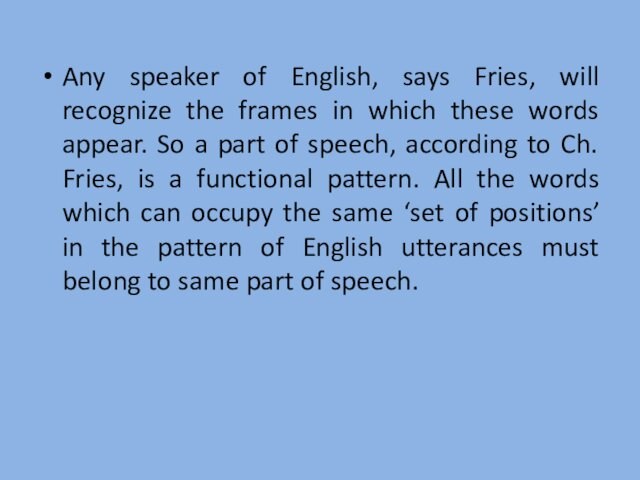
the frames in which these words appear. So a
part of speech, according to Ch. Fries, is a functional
pattern. All the words which can occupy the same ‘set of positions’ in the pattern of English utterances must belong to same part of speech.
Слайд 19
Cognitive linguistics
Langacker (1987, p. 189) has the following
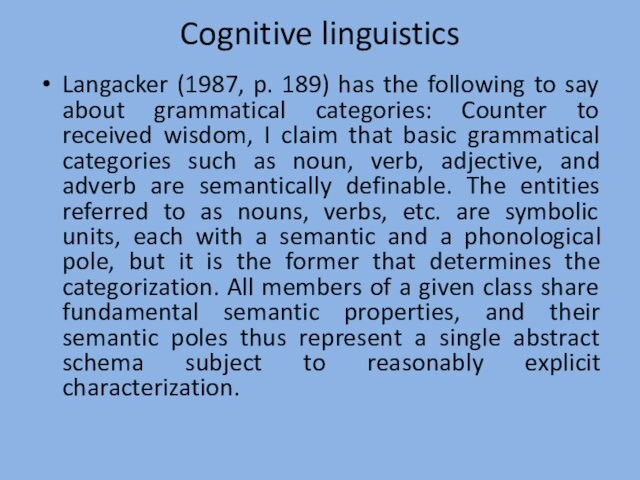
to say about grammatical categories: Counter to received wisdom,
I claim that basic grammatical categories such as noun, verb,
adjective, and adverb are semantically definable. The entities referred to as nouns, verbs, etc. are symbolic units, each with a semantic and a phonological pole, but it is the former that determines the categorization. All members of a given class share fundamental semantic properties, and their semantic poles thus represent a single abstract schema subject to reasonably explicit characterization.
Слайд 20
Thus, a noun is regarded as a symbolic
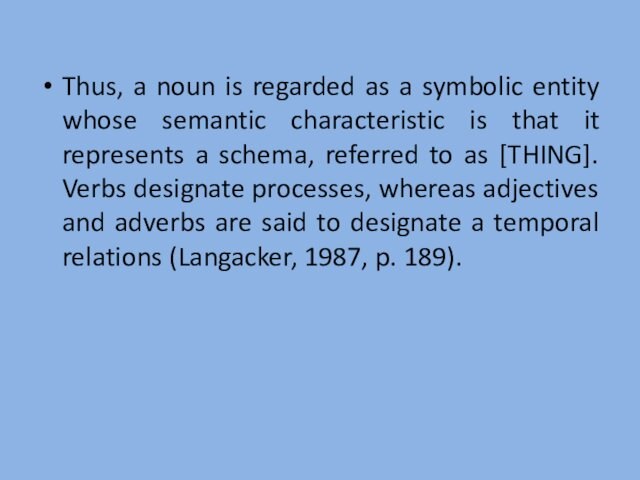
entity whose semantic characteristic is that it represents a
schema, referred to as [THING]. Verbs designate processes, whereas adjectives
and adverbs are said to designate a temporal relations (Langacker, 1987, p. 189).
Слайд 21
Combining the results from a large number of
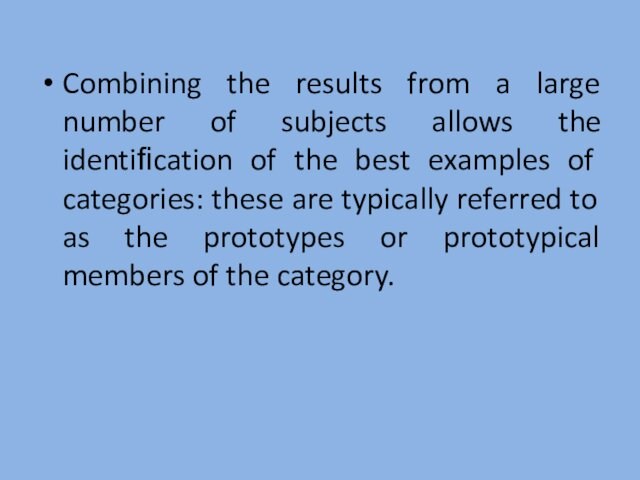
subjects allows the identification of the best examples of
categories: these are typically referred to as the prototypes or
prototypical members of the category.
Слайд 22
So, for instance, if the category was VEGETABLE,
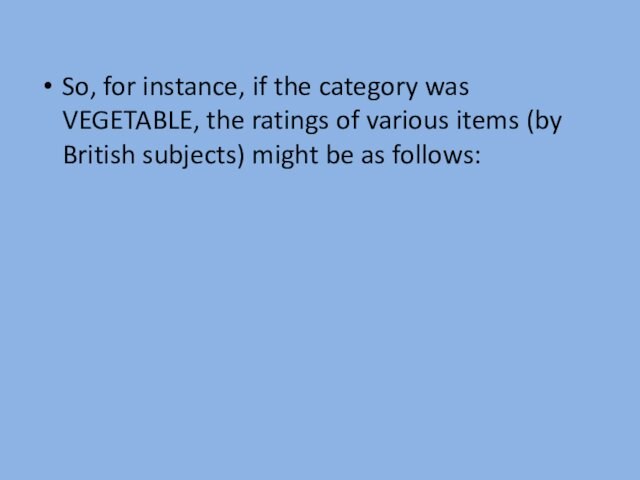
the ratings of various items (by British subjects) might
be as follows:
Слайд 23
LEEK, CARROT 1
BROCCOLI, PARSNIP 2
CELERY, BEETROOT 3
AUBERGINE, COURGETTE
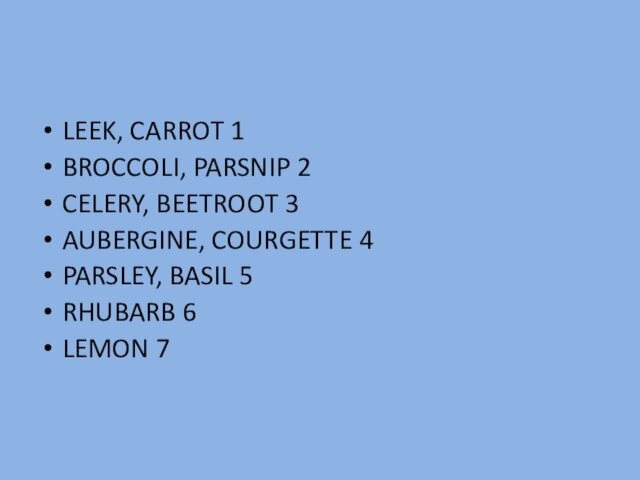
4
PARSLEY, BASIL 5
RHUBARB 6
LEMON 7
Слайд 24
CATEGORIAL STRUCTURE OF THE WORD. GRAMMATICAL CLASSES OF
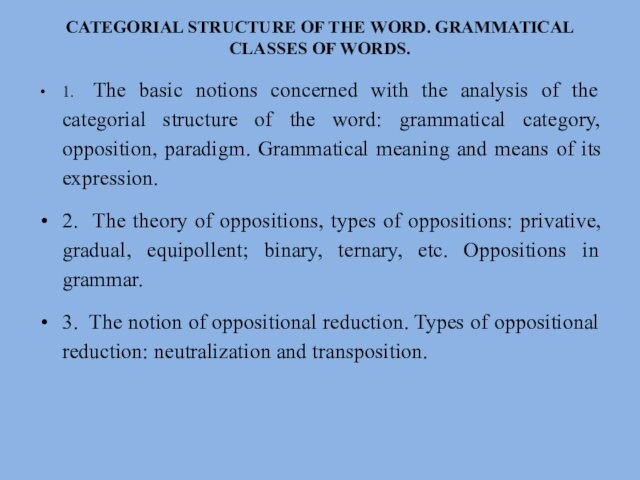
WORDS.
1. The basic notions concerned with the analysis of
the categorial structure of the word: grammatical category, opposition, paradigm.
Grammatical meaning and means of its expression.
2. The theory of oppositions, types of oppositions: privative, gradual, equipollent; binary, ternary, etc. Oppositions in grammar.
3. The notion of oppositional reduction. Types of oppositional reduction: neutralization and transposition.
Слайд 25
Notion of Opposition. Oppositions in Morphology
The most
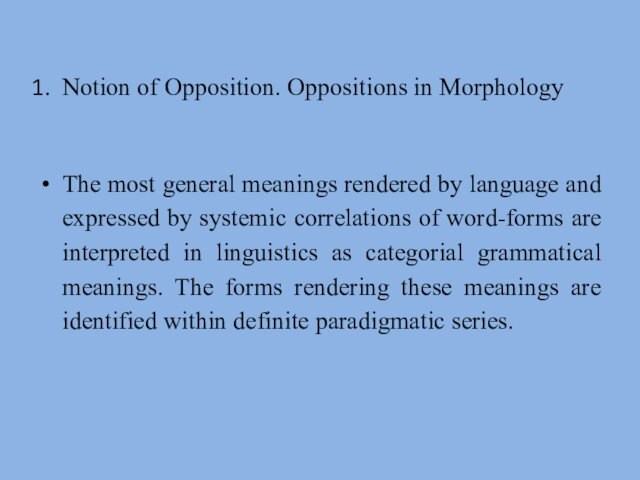
general meanings rendered by language and expressed by systemic
correlations of word-forms are interpreted in linguistics as categorial grammatical
meanings. The forms rendering these meanings are identified within definite paradigmatic series.
Слайд 26
The grammatical category is a system of expressing
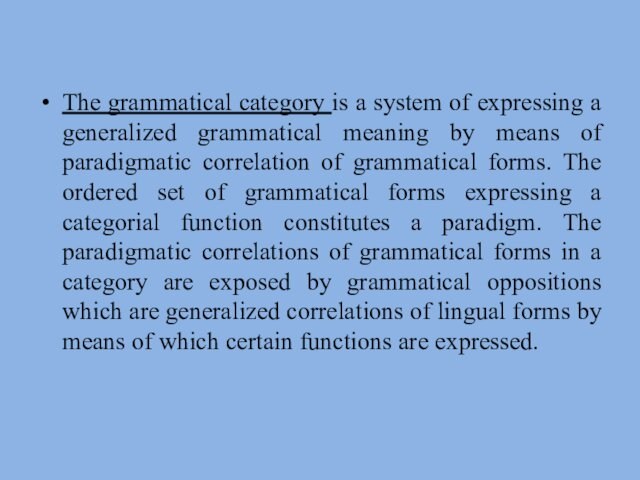
a generalized grammatical meaning by means of paradigmatic correlation
of grammatical forms. The ordered set of grammatical forms expressing
a categorial function constitutes a paradigm. The paradigmatic correlations of grammatical forms in a category are exposed by grammatical oppositions which are generalized correlations of lingual forms by means of which certain functions are expressed.
Слайд 27
There exist three main types of qualitatively different
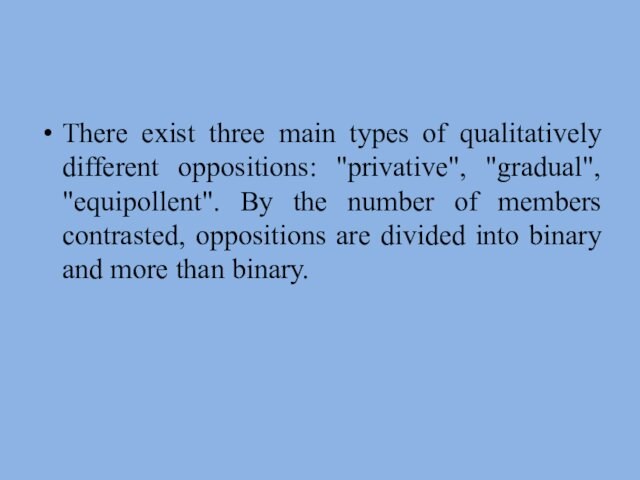
oppositions: «privative», «gradual», «equipollent». By the number of members
contrasted, oppositions are divided into binary and more than binary.
Слайд 28
The privative binary opposition is formed by a
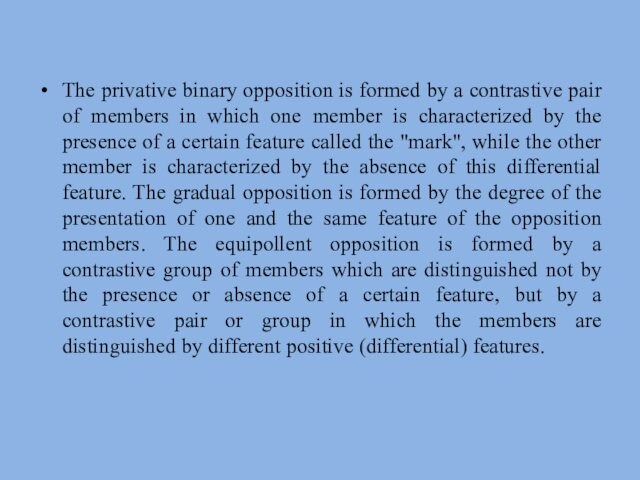
contrastive pair of members in which one member is
characterized by the presence of a certain feature called the
«mark», while the other member is characterized by the absence of this differential feature. The gradual opposition is formed by the degree of the presentation of one and the same feature of the opposition members. The equipollent opposition is formed by a contrastive group of members which are distinguished not by the presence or absence of a certain feature, but by a contrastive pair or group in which the members are distinguished by different positive (differential) features.
Слайд 29
The most important type of opposition in morphology
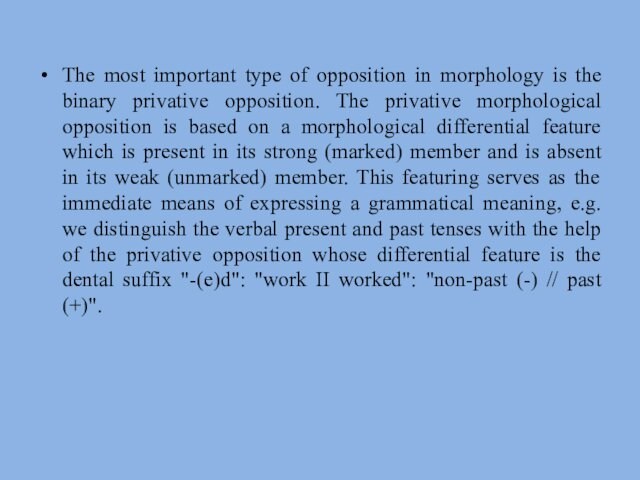
is the binary privative opposition. The privative morphological opposition
is based on a morphological differential feature which is present
in its strong (marked) member and is absent in its weak (unmarked) member. This featuring serves as the immediate means of expressing a grammatical meaning, e.g. we distinguish the verbal present and past tenses with the help of the privative opposition whose differential feature is the dental suffix «-(e)d»: «work II worked»: «non-past (-) // past (+)».
Слайд 30
Gradual oppositions in morphology are not generally recognized;
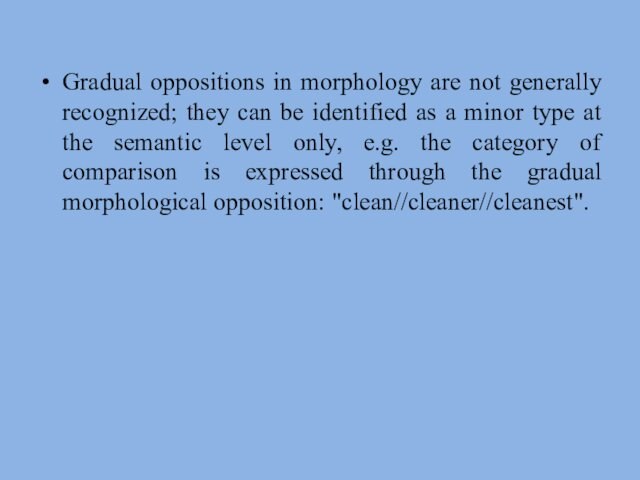
they can be identified as a minor type at
the semantic level only, e.g. the category of comparison is
expressed through the gradual morphological opposition: «clean//cleaner//cleanest».
Слайд 31
Equipollent oppositions in English morphology constitute a minor
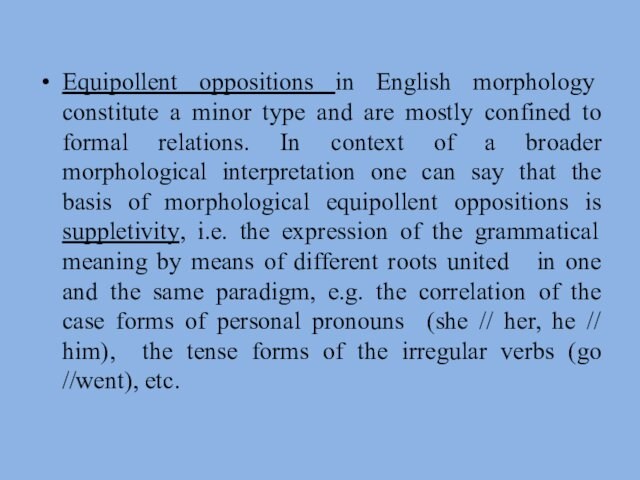
type and are mostly confined to formal relations. In
context of a broader morphological interpretation one can say that
the basis of morphological equipollent oppositions is suppletivity, i.e. the expression of the grammatical meaning by means of different roots united in one and the same paradigm, e.g. the correlation of the case forms of personal pronouns (she // her, he // him), the tense forms of the irregular verbs (go //went), etc.
Слайд 32
Oppositional Reduction
In various contextual conditions, one member
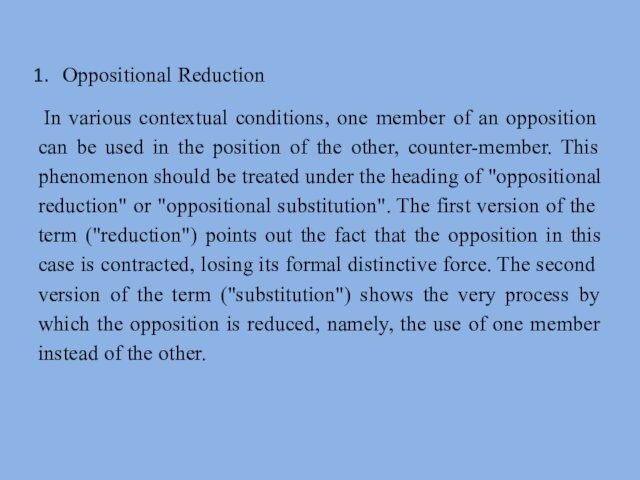
of an opposition can be used in the position
of the other, counter-member. This phenomenon should be treated under
the heading of «oppositional reduction» or «oppositional substitution». The first version of the term («reduction») points out the fact that the opposition in this case is contracted, losing its formal distinctive force. The second version of the term («substitution») shows the very process by which the opposition is reduced, namely, the use of one member instead of the other.
Слайд 33
Man conquers nature.
The noun man in the quoted
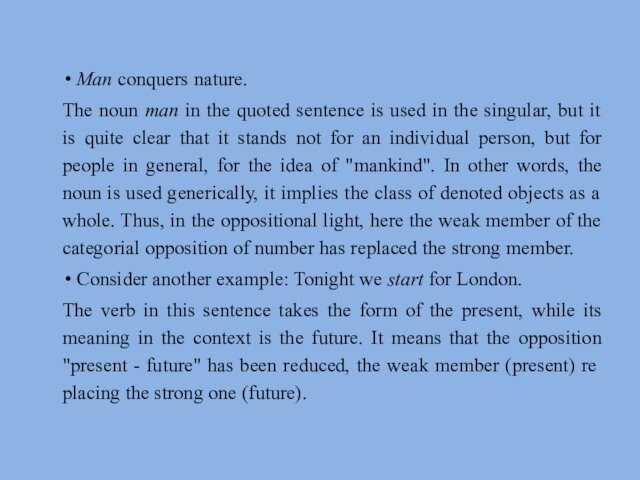
sentence is used in the singular, but it is
quite clear that it stands not for an individual person,
but for people in general, for the idea of «mankind». In other words, the noun is used generically, it implies the class of denoted objects as a whole. Thus, in the oppositional light, here the weak member of the categorial opposition of number has replaced the strong member.
Consider another example: Tonight we start for London.
The verb in this sentence takes the form of the present, while its meaning in the context is the future. It means that the opposition «present — future» has been reduced, the weak member (present) replacing the strong one (future).
